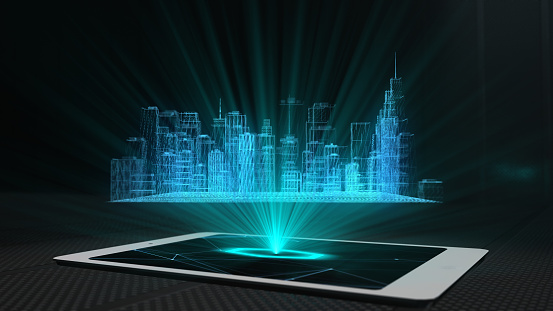Holographic Technology: Shaping the Future of Reality
Holographic technology, once a distant dream reserved for science fiction, is now making significant strides in shaping how we experience the world. From immersive communication to groundbreaking medical advancements, retail innovations, and entertainment transformations, holography is no longer confined to fantasy—it’s becoming a key player in revolutionizing industries and everyday life.
What Is Holographic Technology?
Holographic technology is the art and science of creating three-dimensional images, or holograms, through the manipulation of light. Unlike traditional 2D photographs or screens, holograms offer a more immersive and lifelike experience, allowing viewers to perceive depth and interact with objects from multiple angles. This is achieved by recording the light waves scattered by an object and reproducing them in a way that recreates the original scene.
However, what sets holographic technology apart is its ability to bridge the physical and digital realms. These 3D projections seem to occupy physical space, enabling us to experience virtual objects as though they were tangible. This technology is not only visually impressive but also has the potential to reshape how we engage with information, people, and the world.
Holographic Communication: Redefining Human Interaction
Imagine a future where holographic communication becomes the standard for meetings, presentations, and even casual conversations. Instead of flat video calls, holographic technology allows for immersive, real-time interactions where participants appear as full-sized 3D holograms. Business meetings will no longer be limited by location, as colleagues from across the globe can virtually “sit” at the same table, discussing strategies and ideas in real-time with the added presence of body language and spatial awareness.
On a personal level, holographic video calls could bring loved ones into your living room, even if they are thousands of miles away. The depth and detail provided by holograms could revolutionize how we stay connected, adding a level of emotional closeness that current technology simply can’t provide.
The Medical Horizon: Holographic Breakthroughs in Healthcare
Holographic technology has immense potential in healthcare, particularly in enhancing surgical precision and medical training. Surgeons are already experimenting with holographic models of human anatomy, enabling them to plan procedures with unprecedented clarity. With a 3D holographic model of a patient’s body, a surgeon can examine every angle, understanding the full complexity of the procedure before ever making a cut.
In education, holographic medical training tools are set to transform how students learn about the human body. Instead of static models or diagrams, students will be able to explore dynamic, interactive holographic representations of organs, tissues, and even cellular structures. This allows for a deeper understanding and a more hands-on approach to medical education, preparing future doctors and healthcare professionals with advanced tools that go beyond textbooks.
Retail Reimagined: The Holographic Shopping Experience
The world of retail is on the cusp of a holographic transformation. Imagine walking into a store where instead of browsing physical shelves, you interact with holographic displays of products. Customers could try on holographic clothing, view how different styles look on them without ever stepping into a fitting room, or explore the features of electronics and appliances before making a purchase.
Holographic retail experiences would not only make shopping more engaging but also offer endless possibilities for personalization. For instance, a customer could walk into a store and be greeted by a holographic assistant that knows their preferences, offering tailored suggestions. Retailers could significantly reduce their physical inventory while offering customers the ability to view a wider array of products in a virtual space.

The Entertainment Industry: Holography as the New Frontier
Holographic technology is already making waves in the entertainment world, and it’s only just beginning. From concerts featuring holographic performances of legendary musicians to interactive experiences in gaming and virtual reality, the entertainment industry is embracing holography as the next big thing.
Holographic concerts, where deceased artists or remotely located performers are projected on stage, are becoming increasingly popular. Imagine attending a music festival where holograms of artists perform alongside live acts, creating a one-of-a-kind hybrid experience. This fusion of the digital and physical worlds offers endless possibilities for fan engagement, giving audiences the chance to experience performances in ways that feel more immersive than traditional screens ever could.
In gaming, holographic experiences could revolutionize how players interact with virtual worlds. Instead of being limited to flat screens, holograms could bring characters and game environments into your living room, blending the boundaries between the real and virtual. This level of immersion could redefine storytelling, gaming, and even live theater, where holographic characters interact with real actors on stage.
Challenges and the Path Ahead for Holographic Technology:
Despite its potential, holographic technology faces several challenges before it can become mainstream. The high cost of holographic displays, the need for powerful computing capabilities, and the complexity of creating large-scale holograms are obstacles that still need to be overcome. Additionally, the data required to generate high-quality holographic images is immense, requiring significant advancements in data processing and storage.
However, as technology continues to evolve, these barriers are expected to diminish. Major tech companies are investing heavily in holographic development, and as costs lower, we’re likely to see wider adoption across industries. Once these challenges are addressed, the holographic future we’ve dreamed of could become a reality far sooner than anticipated.
Conclusion: The Dawn of a Holographic Future
Holographic technology is more than just a visual spectacle—it’s a transformative force that’s redefining how we communicate, learn, shop, and entertain ourselves. From holographic video calls that bring distant loved ones into our homes to medical breakthroughs that enhance surgical precision, the potential applications are vast and groundbreaking.
As holography moves from novelty to necessity, it will usher in a new era of digital interaction, one that goes beyond screens and brings the virtual into our physical world. In this new holographic reality, we won’t just see the future—we’ll experience it firsthand.
FAQs:
- What exactly is holographic technology?
Holographic technology involves creating three-dimensional images, known as holograms, through the interference of light beams. Unlike traditional 2D images or videos, holograms provide a lifelike representation of objects, allowing viewers to see them from different angles as if they were physically present. This is achieved by recording and reconstructing light waves to create a 3D visual experience.
- How does a hologram differ from a 3D projection?
While both holograms and 3D projections create the illusion of three-dimensional images, holograms are unique in that they reproduce the full light field of an object. This means that holograms can be viewed from multiple angles and provide a more accurate sense of depth and texture. 3D projections, on the other hand, often rely on visual tricks and can only offer a limited perspective.
- What are some current applications of holographic technology?
Holographic technology is being used in various fields, including:
- Communication: Holographic video calls enable immersive interactions where participants appear as life-sized 3D figures.
- Medicine: Surgeons use holograms to visualize patient anatomy in three dimensions for better planning and precision.
- Retail: Holographic displays allow customers to interact with virtual products, enhancing the shopping experience.
- Entertainment: Holographic performances bring deceased or distant performers to life on stage, and gaming experiences use holography to create immersive virtual worlds.
- What are the key challenges in developing holographic technology?
Despite its potential, holographic technology faces several challenges:
- Cost: Creating high-quality holograms requires advanced equipment and materials, making it expensive.
- Data Processing: High-resolution holograms require significant amounts of data and processing power.
- Complexity: Producing large-scale, interactive holograms involves complex technology and precision.
- How can holography impact future communication?
Holographic technology has the potential to revolutionize communication by making virtual interactions more lifelike. Holographic meetings and video calls could provide a sense of presence and spatial awareness that traditional video conferencing lacks. This could enhance collaboration and make remote interactions feel more personal and engaging.
- Can holograms be used for educational purposes?
Yes, holograms are increasingly being used in education. They can provide dynamic, interactive models of complex subjects such as anatomy, physics, and history. Students can explore 3D holographic representations of concepts, allowing for a more immersive and hands-on learning experience.
- What advancements are needed for holography to become mainstream?
To make holography more accessible, advancements are needed in several areas:
- Cost Reduction: Lowering the cost of holographic technology will make it more affordable for consumers and businesses.
- Data Storage and Processing: Enhancements in data storage and processing capabilities are required to handle high-resolution holograms.
- User Interface: Developing user-friendly interfaces and applications that make holography easy to use will be crucial for widespread adoption.
- How does holographic technology influence the entertainment industry?
In entertainment, holography is transforming how content is created and experienced. Holographic performances can bring iconic artists back to life, while holographic gaming and virtual reality offer new ways to engage with digital content. This technology enhances storytelling by blending physical and virtual elements, creating more immersive experiences for audiences.
- Are there any potential risks or ethical considerations with holographic technology?
Holographic technology raises several ethical and privacy considerations:
- Privacy: Holograms could potentially be used to create misleading or unauthorized representations of individuals.
- Security: Advanced holographic systems may require robust security measures to prevent misuse or unauthorized access.
- Impact on Reality: The immersive nature of holograms could blur the line between reality and virtual experiences, raising questions about perception and authenticity.
- What does the future hold for holographic technology?
The future of holographic technology promises exciting possibilities. As advancements continue, we can expect more affordable and accessible holographic solutions across various sectors. From revolutionizing how we communicate and learn to enhancing entertainment and retail experiences, holography is set to become an integral part of our digital landscape.




